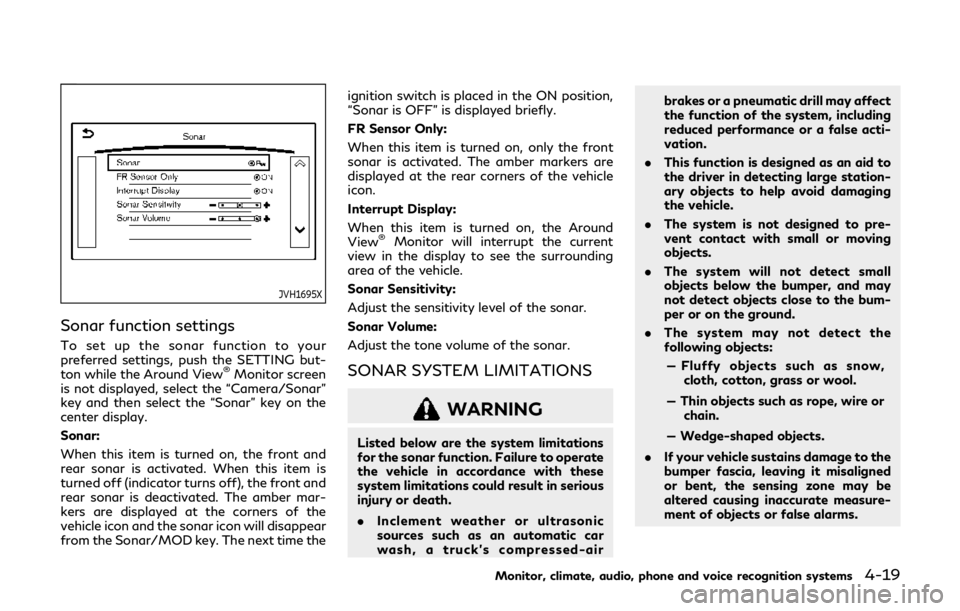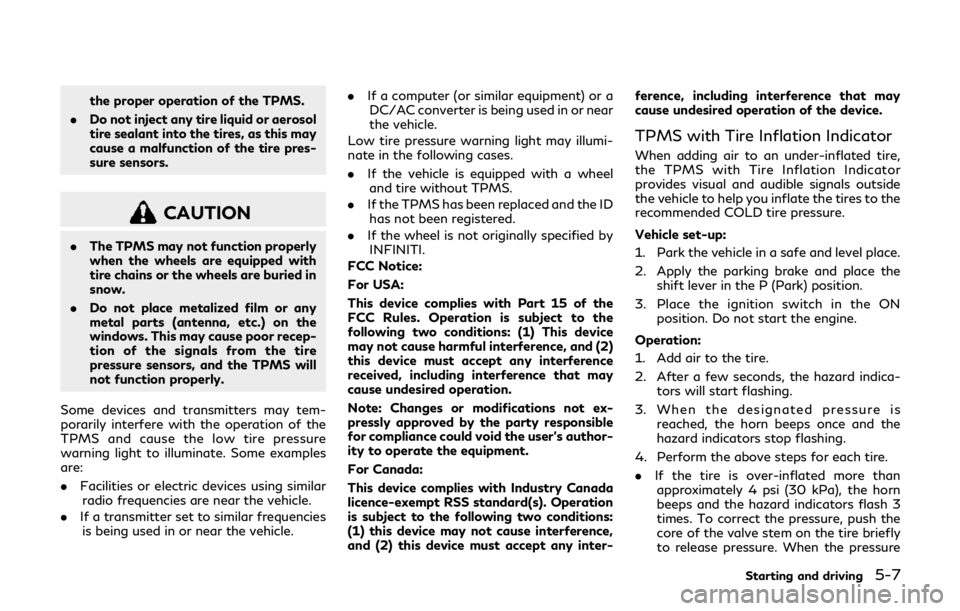sensor INFINITI QX80 2019 Owner's Guide
[x] Cancel search | Manufacturer: INFINITI, Model Year: 2019, Model line: QX80, Model: INFINITI QX80 2019Pages: 524, PDF Size: 2.45 MB
Page 201 of 524

SPA2450-A
Automatic anti-glare type (if so
equipped)
The inside mirror is designed so that it
automatically changes reflection according
to the intensity of the headlights of the
following vehicle.
The anti-glare system will be automatically
turned on when the ignition switch is pushed
to the ON position.
When the anti-glare system is turned on, the
indicator light
will illuminate and excessive
glare from the headlights of the vehicle
behind you will be reduced.
Push the “*” switch
to make the inside
rearview mirror operate normally. The in- dicator light will turn off. Push the “I” switch
to turn the system on.
Do not allow any object to cover the sensors
or apply glass cleaner on them. Doing so
will reduce the sensitivity of the sensor,
resulting in improper operation.
For the HomeLink
®Universal Transceiver
operation, see “HomeLink®Universal Trans-
ceiver (Type A)” (P.2-69).
Smart Rearview Mirror (if so
equipped)
WARNING
. Failure to follow the warnings and
instructions for proper use of the
Smart Rearview Mirror could result
in serious injury or death.
— The Smart Rearview Mirror is a convenience feature but it is not a
substitute for proper vehicle op-
eration. The system has areas
where objects cannot be viewed.
Check the blind spot of the Smart
Rearview Mirror before vehicle
operation. The driver is always
responsible for safe driving.
— Do not disassemble or modify the Smart Rearview Mirror, the cam- era unit or wirings. If you do, it
may result in accidents or fire. In
case you notice smoke or smell
coming from the Smart Rearview
Mirror, stop using the system
immediately. It is recommended
that you see an INFINITI retailer
for servicing.
— Do not operate the Smart Rear- view Mirror while driving. Doing
so can be a distraction and it could
lose control of your vehicle and
cause an accident or serious in-
jury.
— Do not gaze into the Smart Rear- view Mirror display during driv-
ing. It may cause a distraction and
it could lose control of your vehi-
cle and cause an accident or
serious injury.
— Do not put a cigarette or flames to the Smart Rearview Mirror, the
camera unit or wirings. It may
cause a fire.
. Be sure to adjust the Smart Rearview
Mirror before driving. Switch the
system to the conventional rearview
mirror mode and be properly seated
on the driver’s seat. Then adjust the
mirror so as to see the rear window
Pre-driving checks and adjustments3-31
Page 231 of 524

JVH1695X
Sonar function settings
To set up the sonar function to your
preferred settings, push the SETTING but-
ton while the Around View
®Monitor screen
is not displayed, select the “Camera/Sonar”
key and then select the “Sonar” key on the
center display.
Sonar:
When this item is turned on, the front and
rear sonar is activated. When this item is
turned off (indicator turns off), the front and
rear sonar is deactivated. The amber mar-
kers are displayed at the corners of the
vehicle icon and the sonar icon will disappear
from the Sonar/MOD key. The next time the ignition switch is placed in the ON position,
“Sonar is OFF” is displayed briefly.
FR Sensor Only:
When this item is turned on, only the front
sonar is activated. The amber markers are
displayed at the rear corners of the vehicle
icon.
Interrupt Display:
When this item is turned on, the Around
View
®Monitor will interrupt the current
view in the display to see the surrounding
area of the vehicle.
Sonar Sensitivity:
Adjust the sensitivity level of the sonar.
Sonar Volume:
Adjust the tone volume of the sonar.
SONAR SYSTEM LIMITATIONS
WARNING
Listed below are the system limitations
for the sonar function. Failure to operate
the vehicle in accordance with these
system limitations could result in serious
injury or death.
. Inclement weather or ultrasonic
sources such as an automatic car
wash, a truck’s compressed-air brakes or a pneumatic drill may affect
the function of the system, including
reduced performance or a false acti-
vation.
. This function is designed as an aid to
the driver in detecting large station-
ary objects to help avoid damaging
the vehicle.
. The system is not designed to pre-
vent contact with small or moving
objects.
. The system will not detect small
objects below the bumper, and may
not detect objects close to the bum-
per or on the ground.
. The system may not detect the
following objects:
— Fluffy objects such as snow, cloth, cotton, grass or wool.
— Thin objects such as rope, wire or chain.
— Wedge-shaped objects.
. If your vehicle sustains damage to the
bumper fascia, leaving it misaligned
or bent, the sensing zone may be
altered causing inaccurate measure-
ment of objects or false alarms.
Monitor, climate, audio, phone and voice recognition systems4-19
Page 232 of 524

4-20Monitor, climate, audio, phone and voice recognition systems
CAUTION
Excessive noise (such as audio system
volume or an open vehicle window) will
interfere with the tone and it may not be
heard.
SYSTEM TEMPORARILY UNA-
VAILABLE
When the amber markers are displayed at
the corners of the vehicle icon and the
function cannot be activated from the
“Sonar” settings (the setting items are
grayed out), the sonar system may be
malfunctioning.
SYSTEM MAINTENANCE
CAUTION
Keep the surface of the sonar sensors
(located on the front and rear bumper
fascia) free from accumulations of snow,
ice and dirt. Do not scratch the surface
of the sonar sensors when cleaning. If
the sensors are covered, the accuracy of
the sonar function will be diminished.JVH1689X
1. CAMERA button
2. SETTING button
MOVING OBJECT DETECTION (MOD)
Page 241 of 524

.Push the “” outside air circulation
button to draw outside air into the
passenger compartment. The “
” in-
dicator light on the button will come on.
. To control the air intake automatically,
push and hold either the “
” air
recirculation button or the “” outside
air circulation button (whichever indica-
tor light is illuminated). The indicator
lights (both air recirculation and outside
air circulation buttons) will flash twice,
and then the air intake will switch to
automatic control.
Air intake control (With Advanced Climate
Control System):
. Push the “
” air recirculation button to
recirculate interior air inside the vehicle.
The “
” indicator light on the button
will come on. The air recirculation mode
cannot be activated when the air condi-
tioner is in the front defrosting mode
“
”.
. Push the “
” air recirculation button
(the indicator on the button will turn off)
to draw outside air into the passenger
compartment.
. To control the air intake automatically,
push the “
” auto-recirculation but-
ton. The indicator light on the “
”auto-recirculation button will illuminate.
Turning the system off
Push the OFF button.
Upper vent system
When the upper vent “” button is pushed,
the air flow against the driver’s or passen-
ger’s upper body becomes gentle. The
indicator light on the button will illuminate.
In this mode, air from the upper ventilator
flows in order to control the cabin tempera-
ture without blowing air directly on the
occupants.
Push the upper vent “
” button when you
want the air conditioner to work quickly.
To turn the system off, push the upper vent
“
” button to turn the indicator light off.
Advanced Climate Control System
(if so equipped)
The Advanced Climate Control System
keeps the air inside of the vehicle clean,
using the ion control and the automatic air
intake control with exhaust gas detecting
sensor.
JVH1780X
Ion control:
This unit generates highly concentrated
Plasmacluster
®ions into the air blown from
the ventilators and reduces odor absorbed
into the interior trim.
The high-density Plasmacluster
®ions gen-
erated in the air conditioner’s air stream not
only suppress airborne bacteria and reduce
the adherence of odors to the interior trim,
but also have a proven skin moisture pre-
serving effect.
When the air conditioner is turned on, the
system generates Plasmacluster
®ions auto-
matically.
The amount of Plasmacluster
®ions in-
creases according to the amount of air flow.
Monitor, climate, audio, phone and voice recognition systems4-29
Page 242 of 524

4-30Monitor, climate, audio, phone and voice recognition systems
When the air flow is high, “” is displayed
on the screen and when the air flow is low,
the indication in the screen changes to “
”.
Plasmacluster®and Plasmacluster®ion are
registered trademarks of Sharp Corporation.
Exhaust gas/outside odor detection sensor:
This vehicle is equipped with an exhaust gas
detection sensor. When the automatic in-
take air control is ON, the sensor detects
industry odors such as pulp or chemicals, and
exhaust gas such as gasoline or diesel. When
such odors or gas are detected, the system
automatically changes from the outside air
circulation mode to the recirculation mode.
When the auto-recirculation button is
pushed under the following conditions, the
indicator light on the “
” button will
illuminate and the exhaust gas detection
sensor will turn on.
. The air flow control is not in the front
defroster mode (the indicator light on the
“
” front defroster button is turned
off).
. The outside temperature is about 32°F
(0°C) or more.
When the automatic intake air control is ON,
for the first 5 minutes, the recirculation
mode is selected to prevent dust, dirt and
pollen from entering the vehicle and cleans
the air inside of the vehicle with positive and
negative ions that are emitted from the ventilator.
After the 5 minutes, the sensor detects
exhaust gas and automatically alternates
between the recirculation mode and outside
air circulation mode.
JVH1630X
Operations on touch panel screen
Climate control settings can be operated on
the touch panel screen. Push the “CLIMATE”
button and turn the display to the Climate
screen.
For details of the touch panel operation on
the center display, see the separate INFINITI
InTouch
TMOwner’s Manual.
Page 247 of 524

OPERATING TIPS
When the engine coolant temperature and
outside air temperature are low, the air flow
from the foot outlets may not operate.
However, this is not a malfunction. After
the coolant temperature warms up, the air
flow from the foot outlets will operate
normally.
The sensors
andlocated on the instru-
ment panel help maintain a constant tem-
perature. Do not put anything on or around
the sensors.
LINKING INTELLIGENT KEY
The Climate control system settings can be
memorized for each Intelligent Key. For
more details, see “Setting memory function”
(P.3-41).
IN-CABIN MICROFILTER
Models without Advanced Climate Control
System:
The climate control system is equipped with
an in-cabin microfilter which collects dirt,
pollen, dust, etc.
Models with Advanced Climate Control
System:
The climate control system is equipped with
a natural grape seed polyphenol filter which
collects and neutralizes dirt, pollen, dust, etc. To make sure the air conditioner heats,
defogs, and ventilates efficiently, replace
the filter in accordance with the specified
maintenance intervals listed in the “9. Main-
tenance and schedules” section. If replace-
ment is required, it is recommended you visit
an INFINITI retailer for this service.
The filter should be replaced if the air flow
decreases significantly or if windows fog up
easily when operating the heater or air
conditioner.
SERVICING CLIMATE CONTROL
The climate control system in your vehicle is
charged with a refrigerant designed with the
environment in mind.
This refrigerant will
not harm the earth’s ozone layer. However,
special charging equipment and lubricant are
required when servicing your air conditioner.
Using improper refrigerants or lubricants will
cause severe damage to your climate control
system. (See “Capacities and recommended
fluids/lubricants” (P.10-2) for climate con-
trol system refrigerant and lubricant recom-
mendations.)
Your INFINITI retailer will be able to service
your environmentally friendly climate control
system.
WARNING
The system contains refrigerant under
high pressure. To avoid personal injury,
any air conditioner service should be
done only by an experienced technician
with the proper equipment.
Monitor, climate, audio, phone and voice recognition systems4-35
Page 252 of 524

Turning the BSI system ON/OFF ........................ 5-45
How to enable/disable the BSI system .............. 5-46
BSI system limitations ............................................. 5-46
BSI driving situations ............................................... 5-47
System temporarily unavailable ............................ 5-53
System malfunction .................................................. 5-54
System maintenance ................................................ 5-54
Back-up Collision Intervention (BCI) (if
so equipped) ..................................................................... 5-55 BCI system operation .............................................. 5-57
How to enable/disable the BCI system ............. 5-61
BCI system precautions ........................................... 5-62
System temporarily unavailable ............................ 5-63
System malfunction .................................................. 5-64
System maintenance ................................................ 5-64
Cruise control (if so equipped) .................................... 5-65 Precautions on cruise control ................................ 5-65
Cruise control operations ....................................... 5-65
Intelligent Cruise Control (ICC) (if so equipped) ..... 5-66 How to select the cruise control mode ............... 5-68
Vehicle-to-vehicle distance control mode ......... 5-68
Conventional (fixed speed) cruise
control mode ............................................................. 5-84
Distance Control Assist (DCA) (if so equipped) ..... 5-87
DCA system operation ........................................... 5-89
Turning the DCA system ON/OFF ...................... 5-92
How to enable/disable the DCA system ........... 5-93
DCA system display and indicators ..................... 5-93
DCA system limitations ........................................... 5-94 System temporarily unavailable .......................... 5-97
System malfunction ................................................ 5-99
Sensor maintenance ............................................... 5-99
Forward Emergency Braking (FEB) with
pedestrian detection .................................................. 5-100 FEB with pedestrian detection
system operation .................................................. 5-102
Turning the FEB with pedestrian detection
system ON/OFF .................................................. 5-104
FEB with pedestrian detection
system limitations ................................................ 5-105
System temporarily unavailable ....................... 5-108
System malfunction ............................................. 5-109
System maintenance ........................................... 5-109
Predictive Forward Collision
Warning (PFCW) ......................................................... 5-110 PFCW system operation ..................................... 5-112
Turning the PFCW system ON/OFF .............. 5-113
PFCW system limitations ................................... 5-115
System temporarily unavailable ........................ 5-117
System malfunction .............................................. 5-117
System maintenance ............................................ 5-118
Break-in schedule ......................................................... 5-119
Fuel efficient driving tips ........................................... 5-119
Increasing fuel economy ........................................... 5-120
INFINITI all-mode 4WD
®(if so equipped) .......... 5-120
INFINITI all-mode 4WD®system .................... 5-121
4WD shift switch .................................................. 5-125
4WD shift indicator .............................................. 5-126
Page 257 of 524

the proper operation of the TPMS.
. Do not inject any tire liquid or aerosol
tire sealant into the tires, as this may
cause a malfunction of the tire pres-
sure sensors.
CAUTION
.The TPMS may not function properly
when the wheels are equipped with
tire chains or the wheels are buried in
snow.
. Do not place metalized film or any
metal parts (antenna, etc.) on the
windows. This may cause poor recep-
tion of the signals from the tire
pressure sensors, and the TPMS will
not function properly.
Some devices and transmitters may tem-
porarily interfere with the operation of the
TPMS and cause the low tire pressure
warning light to illuminate. Some examples
are:
. Facilities or electric devices using similar
radio frequencies are near the vehicle.
. If a transmitter set to similar frequencies
is being used in or near the vehicle. .
If a computer (or similar equipment) or a
DC/AC converter is being used in or near
the vehicle.
Low tire pressure warning light may illumi-
nate in the following cases.
. If the vehicle is equipped with a wheel
and tire without TPMS.
. If the TPMS has been replaced and the ID
has not been registered.
. If the wheel is not originally specified by
INFINITI.
FCC Notice:
For USA:
This device complies with Part 15 of the
FCC Rules. Operation is subject to the
following two conditions: (1) This device
may not cause harmful interference, and (2)
this device must accept any interference
received, including interference that may
cause undesired operation.
Note: Changes or modifications not ex-
pressly approved by the party responsible
for compliance could void the user’s author-
ity to operate the equipment.
For Canada:
This device complies with Industry Canada
licence-exempt RSS standard(s). Operation
is subject to the following two conditions:
(1) this device may not cause interference,
and (2) this device must accept any inter- ference, including interference that may
cause undesired operation of the device.
TPMS with Tire Inflation Indicator
When adding air to an under-inflated tire,
the TPMS with Tire Inflation Indicator
provides visual and audible signals outside
the vehicle to help you inflate the tires to the
recommended COLD tire pressure.
Vehicle set-up:
1. Park the vehicle in a safe and level place.
2. Apply the parking brake and place the
shift lever in the P (Park) position.
3. Place the ignition switch in the ON position. Do not start the engine.
Operation:
1. Add air to the tire.
2. After a few seconds, the hazard indica- tors will start flashing.
3. When the designated pressure is reached, the horn beeps once and the
hazard indicators stop flashing.
4. Perform the above steps for each tire.
. If the tire is over-inflated more than
approximately 4 psi (30 kPa), the horn
beeps and the hazard indicators flash 3
times. To correct the pressure, push the
core of the valve stem on the tire briefly
to release pressure. When the pressure
Starting and driving5-7
Page 282 of 524

5-32Starting and driving
.Do not strike or damage the areas around
the camera unit. Do not touch the
camera lens or remove the screw located
on the camera unit. It is recommended
you contact an INFINITI retailer if the
camera unit is damaged due to an
accident.
WARNING
Failure to follow the warnings and
instructions for proper use of the BSW
system could result in serious injury or
death.
. The BSW system is not a replacement
for proper driving procedure and is
not designed to prevent contact with
vehicles or objects. When changing
lanes, always use the side and rear
mirrors and turn and look in the
direction your vehicle will move to
ensure it is safe to change lanes.
Never rely solely on the BSW system.
. There is a limitation to the detection
capability of the radar. Not every
moving object or vehicle will be
detected. Using the BSW system
under some road, ground, lane mar-
ker, traffic or weather conditions
could lead to improper system opera-
tion. Always rely on your own opera-
tion to avoid accidents.
The BSW system helps alert the driver of
other vehicles in adjacent lanes when chan-
ging lanes.
JVS1146X
The BSW system uses radar sensorsinstalled near the rear bumper to detect
other vehicles in an adjacent lane.
BLIND SPOT WARNING (BSW) (if
so equipped)
Page 283 of 524

SSD1030
Detection zone
The radar sensors can detect vehicles on
either side of your vehicle within the detec-
tion zone shown as illustrated. This detec-
tion zone starts from the outside mirror of
your vehicle and extends approximately 10
ft (3.0 m) behind the rear bumper, and
approximately 10 ft (3.0 m) sideways.
Starting and driving5-33